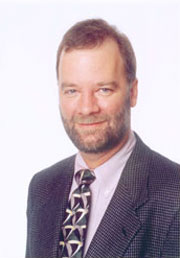|
Conversation
with geneticist Richard Myers
Q: Last year the final human genome sequence was
announced. What do we now know about the human genome from this
international sequencing effort?
A: People used to think that there were about
100,000 genes in the human genome. It turns out that there are only
roughly 30,000 genes, but those genes may make millions of proteins
because each gene can be read in different ways. Of the 3 billion
base pairs in the human genome, only 5 percent looks like it is
important. Of that 5 percent, only half codes for proteins. The
remaining 2.5 percent regulates when and how those genes are turned
on. Even identifying that 5 percent of the genome turns out to be
nontrivial, and that's just building the parts list for the genome.
Then we want to find out what those genes do. I think it's going to
take us 100 years to read this book of life.
Q: What about the remaining 95 percent of the
genome?
A: We don't know. It could be that it's just
important to have a certain amount of space in the genome, or that
DNA could play a role in replication, cell division or the
structure of the DNA. Some of it may also play a role in regulating
genes.
Q: How do you tell which parts of the genome are
important?
A: The important parts are conserved in different species.
If it's a sequence that makes a critical protein, it will remain
similar even in distantly related animals. Less important regions
of the genome have a lot of variability. That's one reason why it's
important to sequence organisms that aren't closely related to
humans. If you sequence only humans and chimpanzees, which are our
closest relatives, the entire sequence will be quite similar and
you can't learn which sequences are most important. I'm on a
government committee along with other professors at Stanford
including Arend Sidow and David Kingsley to decide which other
organisms should be sequenced. You want to look at the evolutionary
tree and make sure you have representative animals from all the
branches, even if they seem kind of obscure. There's a lot of
interesting biology to be learned from sequencing marsupials, for
example.
Q: How has the human genome changed the way science is
done?
A: We used to ask questions one gene at a time. Now you
can think about experiments on a large scale. We're not just
looking at regulatory sequences for one gene. We're looking at
those sequences for all genes. We're not just asking what role one
gene plays in development. We're asking how all genes interact.
These types of experiments wouldn't be possible without sequence
data.
Q: What are some interesting questions in the field of
genetics?
A: The hot new problem has actually been a problem
since scientists have been studying biology: Why does this cell do
one thing and this cell do another? The liver cell and nerve cell
have exactly the same DNA but why are they so different? A big part
of answering that question is to figure out what genes are turned
on in the different cells and how those genes are regulated. Even
though this research has been going on for a long time, we're now
approaching the question in a different way. We can now look at the
expression and behaviors of all genes in each cell type to learn
how they are different.

|

Richard Myers, PhD, is the
Stanford W. Ascherman, MD, FACS, Professor in
Genetics and chair of the Department of Genetics. He is also
director of the Stanford Human Genome Center.
Med school appoints Myers, Warnke to professorships
(10/29/03)
Beyond
the beginning: plotting future genome research (4/16/03)
Genome
research at medical center boosted by $8 million national grant
(10/15/03)
Stanford Human Genome
Center
|

